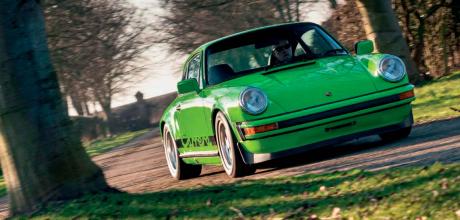European-spec 1974 Porsche 911 Carrera 2.7 MFI
With a nod to hippy psychedelia, Porsche’s colour palette in the late 1960s and early 1970s was as wild and edgy as they come, complementing evolutions in the 911’s styling andengineering. This early Carrera 2.7 ticks all the boxes. What’s more, it could be yours…
Words Johnny Tipler
Photography Dan Sherwood
TRUE SURVIVOR IN THE LIMELIGHT
Time with an early 911 Carrera 2.7.
Today’s plaything is an absolute corker. It blends in well with the scenery, especially if you’re parked up in a lime grove. I’m a sucker for a freak-out colour and it’s no surprise this slice of key lime hits the spot. “What is it?” you ask. Well, as it happens, it’s a rather rare 911: a European-spec 1974 Porsche 911 Carrera 2.7 MFI carrying matching numbers and sharing the same mechanical fuel-injected engine, as well as suspension and gearbox, as the hallowed Carrera RS 2.7. And it’s presented in its original Porsche finish of Lime Green. We’ve come to drool over this air-cooled gem at The Old Racing Car Company, run by Roy Kent from his base in rural north Norfolk, where the car is currently being offered for sale.
IT’S MUCH LIVELIER THAN I WAS EXPECTING, THOUGH I CAN’T IMAGINE THE ADDITIONAL 100CC MAKES ALL THAT MUCH DIFFERENCE
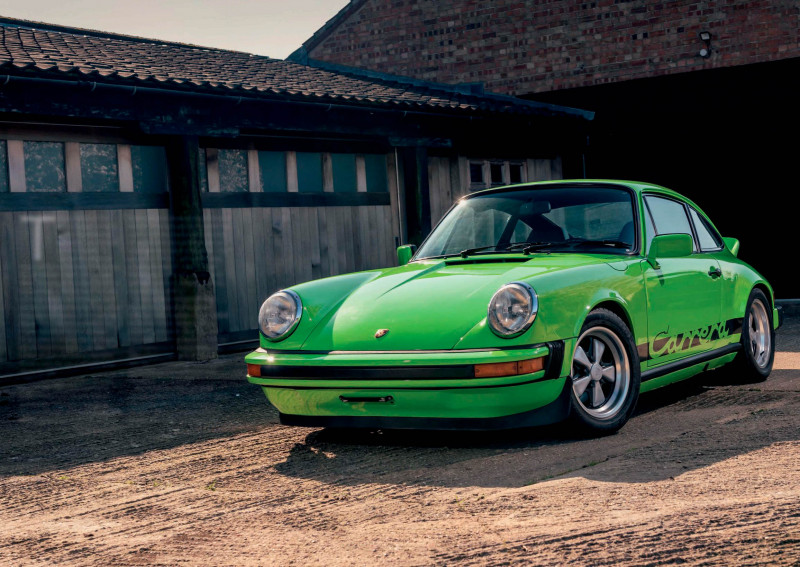
The middle years of the 911 life-story, from 1974 to 1989, turned out to be a model of stability for Porsche product specification. The frenetic changes in chassis dimensions, body styling, adoption of fuel injection and, most of all, shifts in engine capacity characterising Porsches in the late 1960s and early 1970s settled into a pattern of base models which endured for almost a decade-and-a-half, with just three really significant introductions. First up was the 1974 2.7, with three models on offer: the basic 911, the 911 S and the Carrera 2.7. The latter is what we’ve got here, using the 210bhp unit from the outgoing Carrera RS 2.7.
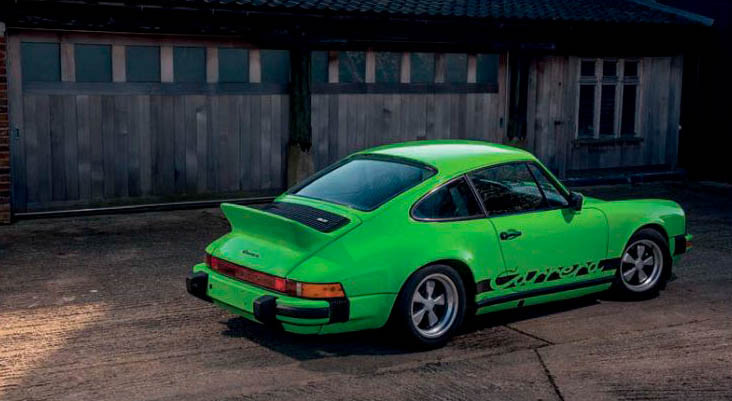
CREATED IN AN ERA WHEN MACHINERY WORKED WITH COGS AND LEVERS, THE MFI PUMP EMPLOYS A SERIES OF MECHANICAL DEVICES
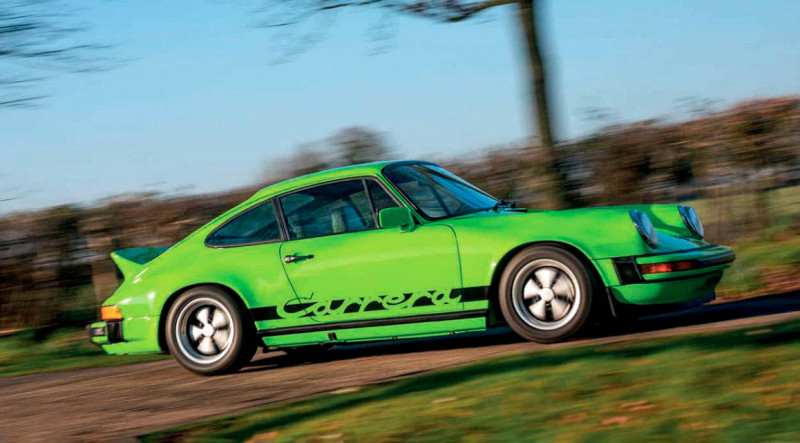
As well as the controversial raised bumper line, calculated to appease American safety regulators, 911s destined for the USA were humbled by stifling emissions equipment. The 2.7-engined cars also embody the transition from flatsix screamers to the torquier three-litre units ushered in by the Carrera 3.0, just a year later, in 1975, before being dropped (along with the 2.7-litre 911), in 1978, making way for the 911 SC.
The concertina-rubber and raised impact-bumper look for 1974’s 911 line-up was greeted with a certain amount of derision at the time, mostly on aesthetic grounds. “What have they done to ourpretty 911?” gasped the pundits. The new styling and what lay beneath it, however, was imperative to ensure the 911 could comply with stringent new safety legislation coming in the USA and Europe, which meant all cars had to be able to withstand a 5mph impact without sustaining any structural damage. Something just as fundamental was afoot, too. Porsches were equally as prone to rust as any other steelbodied cars. Few long-term precautions had been taken to keep corrosion at bay. Porsche tackled the problem by introducing zinc-dipped galvanised steel for all 911 body panels and was the first manufacturer to offer a six-year corrosion warranty on the main body, albeit excluding the wings.
As we know, the 1973 Carrera RS 2.7 was a runaway hit, translating the marque’s prolific competition achievements into a road-going racer. The plan was to continue this success story into 1974, but the previously mentioned incoming US crash safety standards resulted in the new G-series 911, introducing the shock-mounted impact bumpers, a stronger floorpan, revised lighting and, in the case of the US-market cars, a return to the emissions-controlled 175bhp engine used in the 911 S. Significantly, as mentioned earlier, the European-spec 1974 Carrera retained the 210bhp type 911/83 2.7-litre mechanical fuel injection (MFI) engine from the RS, as well as the model’s suspension and the Type 915/06 five-speed manual gearbox. Additionally, the wheel arches and rear quarters of the new Carrera 2.7 MFI were modestly flared (RS-style) to accept seven- and eight-inch-wide Fuchs forged alloys. The running gear included new forged aluminium rear trailing arms, 20mm front and 18mm rear anti-roll bars, Bilstein sport shock absorbers and vented disc brakes on all four corners, the result being ride and handling characteristics near identical to the much vaunted RS.
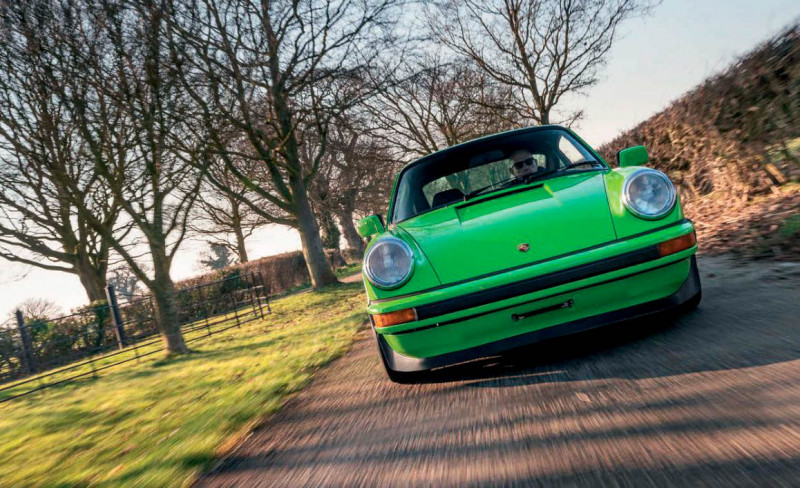
EARLY LEARNING
The authoritative Roy affirms the pedigree. “As you probably know, this model, the 1974 911 Carrera, is the direct successor to the RS Touring and carries the same 2.7-litre MFI engine. This car was built in September 1973, just as the RS Touring was discontinued, meaning this was the first of the new generation cars with the G-series body and those instantly recognisable impact bumpers, a big visual marker.” Not to mention the fabulous Lime Green finish, factory paint code 137. “Nothing speaks more of 1970s Porsches than their range of Day-Glo colours,” he smiles. “They’re just fabulous. I personally think this is one of the best. It’s just so eye-catching.” For a short period, then, the 2.7- litre Carrera was the direct successor to the Carrera RS, and by a quirk of legislation, it was actually built in smaller numbers: 1,580 units of the Carrera RS 2.7 versus 1,036 Carrera 2.7 coupés and 433 Targas. The 2.7 MFI car was also more expensive than the RS. Today, for obvious reasons, the Euro-spec version has become significantly more desirable than the US-delivered model. “Ironically, they made fewer of these cars than they did the RS 2.7 Touring,” confirms Roy, “but obviously, the RS Touring remains the most coveted. That said, while an RS Touring will set you back about half-a-million quid in the present, a 2.7-litre Carrera will cost about half. In a sense, this model is a bargain. I can’t look at it in any other way.”
He acknowledges it has taken time for the Carrera 2.7 to be appreciated, and it likely needs more time for the impact-bumper 911 family as a whole to achieve the same level of adoration as the original long-bonnet shape. After all, you could argue the original 911 design, including the RS Touring, has a much cleaner purity of line. “I think impact-bumper cars are now finding a new following with a younger audience,” Roy reasons. “I’m referring to enthusiasts who grew up with the 911 looking like this. These Porsche fans don’t find accordion-style bumpers odd, unlike many who qualify as an older generation of Porsche purist. The long-bonnet cars are slightly old-fashioned in that sense, while the G-series has a far more contemporary look. It certainly doesn’t look like a car fast approaching its fiftieth anniversary.” I don’t argue.
As for this particular 911’s history and provenance, it was first registered in September 1973 and delivered to Raffay, Hamburg. The car spent the first six years of its life in Europe before it was sold to a Japanese buyer in 1980. It remained in the Land of the Rising Sun for almost forty years until it was sold to Danish collector, Jorgen Stroller Hansen, in October 2017, in whose possession it remained (alongside his huge fleet of 120 additional cars) until 2021.
OCEANS APART
“Although this 911 was in Japan for four decades, there’s very little evidence of what happened to it on a day-to-day basis,” Roy concedes. Nevertheless, this beautiful Porsche was superbly restored to virtually concours condition, though nailing down who did what, and when, has been very difficult to establish — the Danish collector was fairly vague on the subject, acquiring cars taking his fancy without knowing too much about their history. The mileage states 46,000km, which is, of course, debatable. Further investigation was required.
It took a while, and some deep digging, for Roy to come up with names and dates. “The key discovery,” he reports, “was the correlation between bills in the history file, amounting to between £25,000 and £30,000, from a company named Technical Mate International, located in Kanagawa, just south of Tokyo in Japan, and the appearance of the car on the associated Instagram account. These included pics of the interior during restoration, the car on display in the company workshop, in its showroom and at Techno Classica Essen, where it was possibly purchased for or by a previous owner. The Instagram images date from 2016 and were reposted up to 2018. Among them is a particularly good studio shot of the car with a Kawasaki 400 H2 motorcycle of the same age and, interestingly, finished in a similar colour.”
FRIEND WITH BENEFITS
Technical Mate International was founded in 1991, although its last social media post appears to have been published in 2019. It transpires the firm’s founder, Yutaka Ishizuka, now runs Neunelf 911, offering “thirty-one years of experience in working exclusively on vintage Porsches,” with the promise “we aim to restore these Carreras using our well-experienced Japanese craftsmanship.” Neunelf 911 is active on Instagram, but the company website returns a 404 error page. More mystery. Closer to home, The Old Racing Car Company majors on immaculate toolroom copies of important Ferraris, Maseratis, Jaguars and so on. Roy is a wealth of knowledge on the classic car scene. “You can see why this 911 lingered in Japan for so long,” he says. “The country’s love for the model is no secret. In fact, over the decades, Porsche remains Japan’s best-selling imported sports car brand by a considerable margin. This is reflected in the burgeoning Japanese economy of the late 1970s, through to the early 1990s. It didn’t take long for wellheeled petrolheads to get their hands on cars to modify. Soon, a regular 911 Turbo wasn’t enough. Aftermarket specialists, including RUF Automobile, FVD Brombacher and TECHART filled the gap to satisfy demand for high-power variants. When Porsche sports cars trickled down-market and became more affordable, many more owners started modifying them in their own garages and workshops. This paved the way for the likes of RAUH-Welt BEGRIFF (RWB) to extravagantly modify 911s beyond what had been seen before.”
The bottom line is, 911s are ubiquitous in Japan, and this brings us back to Yutaka Ishizuka, who founded Technical Mate International aged just twenty-four, going on to establish Neunelf 911 in September 2019, carrying over most of his staff from one company to the other, by which time our Lime Green Porsche was back in Europe. “I acquired it in a deal for a car The Old Racing Car Company had in stock,” Roy tells me. “Jorgen Stroller Hansen was very keen to get hold of it. As a result, I brokered the deal between him and the 911’s current owner, on whose behalf I am now selling.”
While this classic Porsche has been at The Old Racing Car Company, it’s had a full engine rebuild, encouraged by an oil leak. “When the casings were taken apart, it was discovered that when the two halves of the engine had been put back together during a previous rebuild, the wrong sealant had been used, hence the oil leak. This was the only concern. Everything else on the car has been done to a fantastically high standard. The body, interior and running gear is all outstanding, but since the flat-six had to come apart, I thought it was worth going through the entire engine to make sure it’s as good as it can possibly. Consequently, it has now been uprated to 2.8-litres through the use of bigger barrels and pistons.
The mechanical fuel injection system was also completely overhauled, which is far from a five-minute job!” And now, we come to the tricky bit. Stay focused, because here comes the tech: MFI — not to be confused with a now defunct retailer of medium density fibreboard (MDF) — was originally introduced on the 906 sports-racing car in 1966. I got the gist of its construction and workings from my go-to techie, Mike Van Dingenen, head mechanic at Antwerp-based Porsche restoration specialist and trackday organiser, 911 Motorsport. “The MFI fuel pump was developed by Kugelfischer and later built by Bosch,” he told me. “Then, in 1967, it was fitted to the 911 R competition car, before making its road-going debut on the two-litre 911 S of 1969. Up to this point, all 911s employed carburettors to instil the air-fuel mixture, but incoming emissions regulations at the end of the 1960s, as well as the demonstrable increase in power provided by injection, led to the introduction of mechanical fuel injection. The MFI pump is compact, but a very complicated piece of equipment. In a way, it’s a microcosm of a full-size engine, containing a busy, co-responding assortment of levers, plungers, gears and valves. You don’t actually see it when peering into the 2.7’s engine bay, though the attendant plastic air-intake paraphernalia is a clue that something different is going on.”
The clue’s in the name. Created in an era when machinery worked with cogs and levers (that’s to say, before the introduction of electronic sensors and regulators and the digital age), the MFI pump employs a series of mechanical devices to create a constantly changing fuel map, based on throttle position, engine speed and barometric pressure. The lower half of the Kugelfischer pump houses a camshaft phased to match the engine’s firing order, while in the top half, six plungers, one for each cylinder, occupy their own individual barrels. The pump’s camshaft is belt-driven off the crankshaft and, as it revolves, it acts on tappets which, in turn, operate the plungers by means of pushrods. As each plunger drops, it exposes a suction valve through which fuel is sucked towards the injectors, while a return-spring maintains the plunger in position when closed. Injected at between 225-250psi, the increased injection pressure of the MFI unit creates greater atomisation of fuel. This produces a more even flamefront during ignition, resulting in more efficient combustion.
GET SCREWED
According to throttle position, the amount of fuel required is regulated by a pull-rod on the throttle linkage, which adjusts a space-cam housed in the base of the pump. The irregular profile of this cam was shaped to match Porsche’s desired fuel map for each 911 variant, and so it and differs between the T, E, S and RS. The space-cam rotates the plungers with a corkscrew motion, by means of a rack-and-pinion gear, providing the amount of fuel required during their movement within the barrels. There’s a centrifugal governor above this, connected to the camshaft, regulating the amount of fuel flowing through the pump, depending on the engine speed, and there’s a solenoid valve to provide automatic cold-start enrichment. Deceptively simple on the outside, very complicated within. Hundreds, if not thousands, of movements in the throttle-bodies and in the mechanical fuel pump itself are bound to cause wear on moving parts, allowing air to pass through the spindle bushes, corroded throttle chokes, or even a worn cam in the pump itself. Mechanical fuel injection, if working correctly, is a brilliant system, but if there are issues — manifest in poor starting, popping, banging, running rough and inefficient acceleration — an expert reconstruction is called for. Not for our key lime contender, though. Happily, all has been sorted.
In deference to its immaculate presentation and the nature of the narrow Norfolk lanes hereabouts, with the potential for mud and encountering oversized agricultural machinery and equestrians, we don’t go very far with the car — just enough to form an opinion of its capabilities and general feel. The flat-six is eager to bark when I fire it up, and the 915 gearbox is nicely compliant. This 911 certainly drives nicely enough, accelerating swiftly. The zesty 2.7 (2.8 in this case) engine delivers brisk performance and excels between 4,000- and 5,000rpm. It’s much livelier than I was expecting, though I can’t imagine the additional 100cc makes all that much difference. If anything, the car feels more planted than its exalted progenitor, the Carrera RS 2.7. The brakes are sharper, too.
Even though the steering is non-assisted, there’s a lovely weight to it, making it easy to control in a tight, backroad turn-in situation. It manifests a nicely planted feel, more so than the earlier RS, yet it is that model’s very 2.7- litre engine which makes this G-bodied 911 sparkle.
All in, this is a superb period 911, mechanically and bodily sound, finished in a standout colour. Given its rarity in a rarefied market, these qualities help justify the £220,000 asking price. Expensive? Sure, but find another in such good nick. Perhaps, as Roy suggests, this is something of an air-cooled bargain, stood back-to-back with the asking price of Carrera RS 2.7? I guess it depends on the state of your bank balance, but, as it stands, I can’t see this 911 losing value. One thing’s for sure, wherever this air-cooled Porsche goes, it’s sure to brighten up everyone’s day, especially that of the lucky next owner.
Above Immaculate from every angle, this Lime Green air-cooled classic is ready and waiting for adventures with a new owner. Above Away from restoring European sports cars, Roy deals in FIA recreations of classic racing machines, including Jaguars and Ferraris.

Above Porsche’s period colour catalogue was extraordinary, a far cry from the silver, grey, white and black finish of most 911s built in the noughties.Above The car was treated to restoration in Japan before being given a mechanical overhaul in Roy’s care.Above and below The thrill of a Carrera RS 2.7 Touring, but in a classic Porsche package costing half the earlier model.


